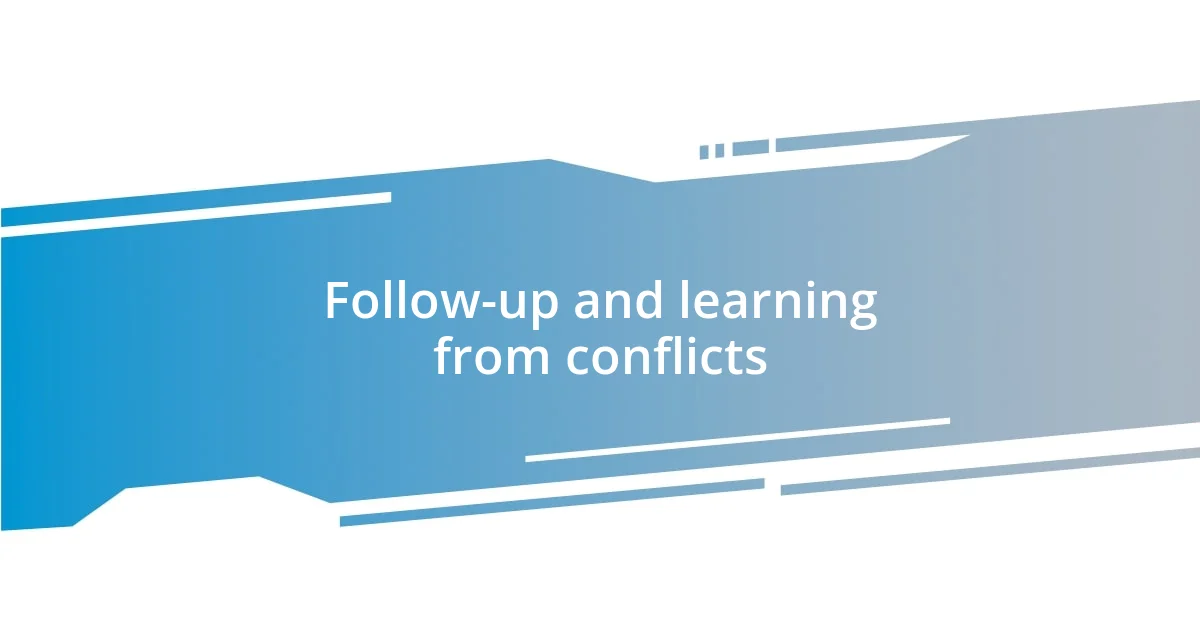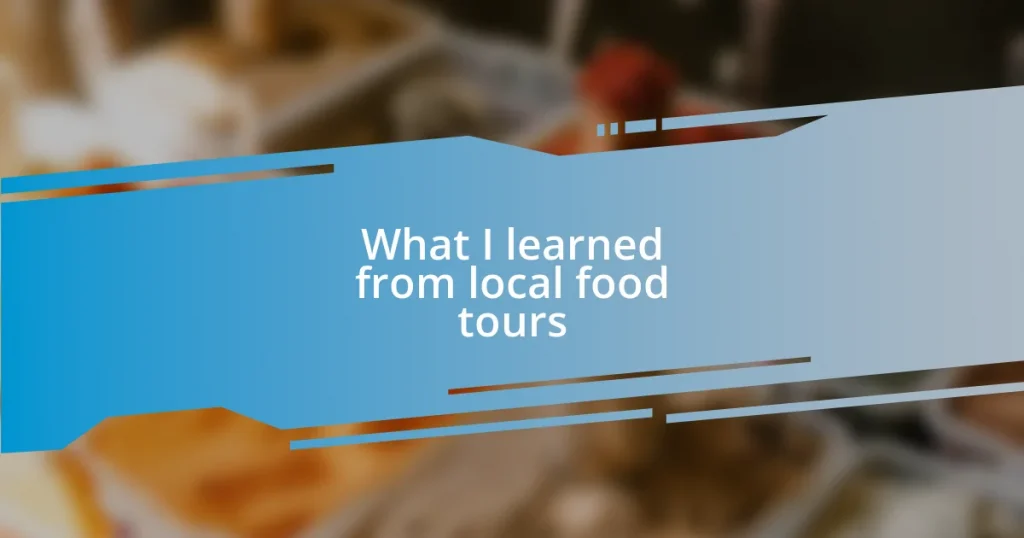Key takeaways:
- Conflicts in bands often arise from creative differences, communication breakdowns, and personality clashes; addressing these issues early promotes a healthier environment.
- Effective communication strategies, such as active listening, “I” statements, and establishing ground rules, can significantly improve collaboration and reduce tensions.
- Following up after conflicts and celebrating resolutions fosters growth, strengthens relationships, and helps identify patterns for future conflict management.

Understanding band conflicts
Conflicts in bands often arise from creative differences, personality clashes, or simply the pressure that comes with working closely with others. I remember a time when the band was split over a song’s arrangement; some wanted a more intricate sound, while others preferred a stripped-down version. It was like watching a teetering seesaw—some days we were up, and other days, we were ready to crash down into chaos.
Communication is crucial during these tough moments. I find that when tensions rise, it’s easy to assume that everyone is on the same page. But in reality, each member may have their own vision and feelings just beneath the surface. Have you ever noticed how a simple misunderstanding can morph into a full-blown argument? When I’ve experienced this, I’ve learned that active listening and acknowledging each member’s perspective can soften the edges of conflict significantly.
Emotions are the unspoken party in the room during band conflicts. I’ve seen heated exchanges spiral out of control, driven more by frustration than by the music itself. At times, I felt the urge to lash out, but taking a step back helped me realize that we were all passionate about what we created together. Ignoring those emotions doesn’t make them disappear; it only amplifies them. So, how can we navigate these emotional waters? I’ve found that fostering an open dialogue, perhaps even during a casual jam session, can transform frustration into creativity.

Identifying common causes
Conflicts in bands often stem from a few common areas that can be identified early on. I’ve noticed that many disagreements arise due to differences in creative vision. For instance, during one rehearsal, a member suggested a major change to our setlist, which didn’t sit well with those who felt strongly about our original choices. This kind of disconnect can lead to tension if not addressed.
Here are some frequent causes of band conflicts:
- Creative Differences: Varying opinions on song arrangements or styles can create friction.
- Personality Clashes: Sometimes, different temperaments or leadership styles just don’t mesh well.
- Communication Breakdowns: Lack of clear communication can lead to misinterpretations and resentment.
- Pressure and Stress: The demands of performing and collaborating can heighten emotions unnecessarily.
- Unequal Contributions: When some members feel they’re contributing more than others, it can breed resentment.
Understanding these triggers is the first step. When I’m aware of them, I find it easier to navigate disputes, often diffusing what could spiral into larger problems. It’s not just about resolving conflicts; it’s about fostering a healthy environment where everyone feels valued and heard.

Effective communication strategies
Effective communication is the backbone of a harmonious band experience. I’ve found that addressing conflicts directly, rather than allowing them to fester, is crucial. I recall a time when we had a disagreement over song lyrics. Instead of letting the issue linger, we initiated a feedback session where everyone had a chance to express their thoughts. It was comforting to see how simply sharing our opinions helped us arrive at a consensus, all while respecting each other’s creativity.
One technique I swear by is using “I” statements to express feelings without blaming others. For example, when discussing a disagreement, saying, “I feel overwhelmed when plans change last minute,” can open up a conversation rather than put others on the defensive. In my experience, this approach encourages openness and can lead to a much more productive dialogue. I still remember the relief on my bandmate’s face when I shared my feelings instead of criticizing their ideas. It shifted our dynamic entirely, allowing us to collaborate more freely.
Lastly, establishing ground rules for communication from the get-go can work wonders. During one of my bands, we decided to implement a ‘no interruptions’ rule during discussions. This simple guideline meant everyone felt heard, and I genuinely noticed how it lessened tension. I encourage you to try this in your band; it might surprise you how much smooth conversation can impact creativity. The inclusion of each member’s voice can transform conflicts into opportunities for growth and deeper understanding.
| Communication Strategy | Description |
|---|---|
| Active Listening | Engaging with others’ opinions and understanding their feelings before responding. |
| I Statements | Expressing personal feelings to foster open conversation without criticism. |
| Establishing Ground Rules | Setting clear communication guidelines to create a respectful dialogue environment. |

Setting clear expectations
Setting clear expectations is an essential step in preventing conflicts before they arise. In my experience, I’ve found that openly discussing roles and responsibilities right at the start can really set the tone for collaboration. For instance, when I joined my last band, we made it a habit to clarify who would handle certain tasks, like setting up equipment or managing social media. It was refreshing to see how this eliminated confusion and helped everyone know what was expected of them.
One time, we faced a situation where one member consistently showed up late for rehearsals. Instead of letting the frustration build, I decided to address it upfront. I asked everyone how we felt about punctuality, and we all agreed that respecting each other’s time was crucial. After that honest discussion, we committed to starting rehearsals on time and checking in with each other if someone was running late. I couldn’t believe the change it made; it created a newfound respect and accountability in our group that had been missing before.
Have you ever noticed how simply establishing guidelines can shift the atmosphere? Every band I’ve been a part of has thrived after we set our expectations regarding rehearsal attendance, song commitments, and creative input. I remember one rehearsal feeling anxious about a specific song arrangement—we hadn’t really discussed it beforehand. But when we finally articulated our individual expectations, it turned into a brainstorming session that sparked new ideas. This approach not only prevents misunderstandings but also builds a sense of unity within the band.

Conflict resolution techniques
When it comes to conflict resolution, active listening can be a game changer. I remember a band rehearsal where tensions flared over a song arrangement. Instead of trying to out-argue each other, we took a step back and let everyone share their viewpoint, one at a time. This not only made people feel valued but also opened our eyes to perspectives we hadn’t considered. It’s incredible how much clarity can arise simply from really hearing each other out.
Another technique that resonates deeply with me is having regular check-ins as a group. I can recall a time when one bandmate seemed disengaged, and it slightly impacted our vibe. Rather than ignore it, we held a casual meeting and encouraged everyone to share how they were feeling about our direction and process. To my surprise, my bandmate shared a lot of frustration about not having enough say during creative decisions. This discussion not only enhanced our understanding but also reignited everyone’s enthusiasm, reminding us just how vital each voice is in the mix.
Lastly, I’ve found that coming together for team-building activities can do wonders for conflict resolution. One weekend, we decided to engage in a fun activity outside of music—like a game night or even a hike. As we laughed and enjoyed each other’s company, the barriers that usually led to misunderstandings began to dissolve. This laughter fostered a sense of camaraderie, proving that sometimes, the best way to handle a conflict is to strengthen the relationships that underpin the collaboration. Have you ever considered how laughter can be a bridge over troubled waters? I can’t recommend it enough.

Encouraging collaboration and teamwork
Encouraging collaboration and teamwork is really about creating a safe space for everyone to express themselves. I recall when we formed our latest band, I suggested we start our practices with a quick round where each of us shared what we enjoyed about the last session. This small act deepened our connection and gave everyone a voice, transforming our energy into something truly collaborative. Isn’t it amazing how just a few moments of sharing can solidify teamwork?
During one particularly challenging rehearsal, I noticed some silent tension brewing among the members. It struck me that we weren’t checking in with each other beyond the songs. So, I proposed a quick “what’s working, what’s not” session after practice. The response was eye-opening! Bandmates began to share their fears and hopes for our music. This simple act not only diffused tension but also reminded us that we’re all in this together, striving for the same harmony.
Another time, after organizing our first gig, I realized I hadn’t fully acknowledged everyone’s contributions. So, I took a moment to highlight each person’s effort during our wrap-up discussion. In that moment, you could see the pride and enthusiasm swell in the room. It’s moments like these that remind me: recognition and appreciation are essential ingredients in the recipe for successful teamwork. Have you ever felt more motivated just from a simple “thank you”? It’s a powerful tool in fostering collaboration.

Follow-up and learning from conflicts
Following up after a conflict is often where the real growth occurs. I remember a particularly heated argument about a song’s final arrangement, which left us feeling somewhat raw. We dedicated a rehearsal to reconvene and discuss not only what happened but also what we learned from it. This reflective session unveiled insights we hadn’t anticipated and ultimately forged a stronger bond among us, proving that sometimes, the best lessons arise from discomfort.
I’ve also found that documenting these conflicts can be incredibly illuminating. In my experience, keeping notes on what triggered the conflict and how we resolved it helps us identify patterns over time. After a few months, I revisited those notes with the band, and it was eye-opening. We discovered recurring themes that needed addressing, which shifted our focus from blame to understanding. Isn’t it fascinating how viewing our conflicts like case studies can lead to valuable insights?
Lastly, I believe celebrating the resolutions is just as crucial as the resolutions themselves. After working through a disagreement, we often take a moment to celebrate our progress—be it small or significant. I recall a time when we wrapped up a tricky situation with a round of drinks and laughter. This act not only solidified our lessons learned but also reinforced that conflicts, when handled well, could enhance our overall journey together. Have you ever appreciated how a rough patch can lead to even deeper connections?
















